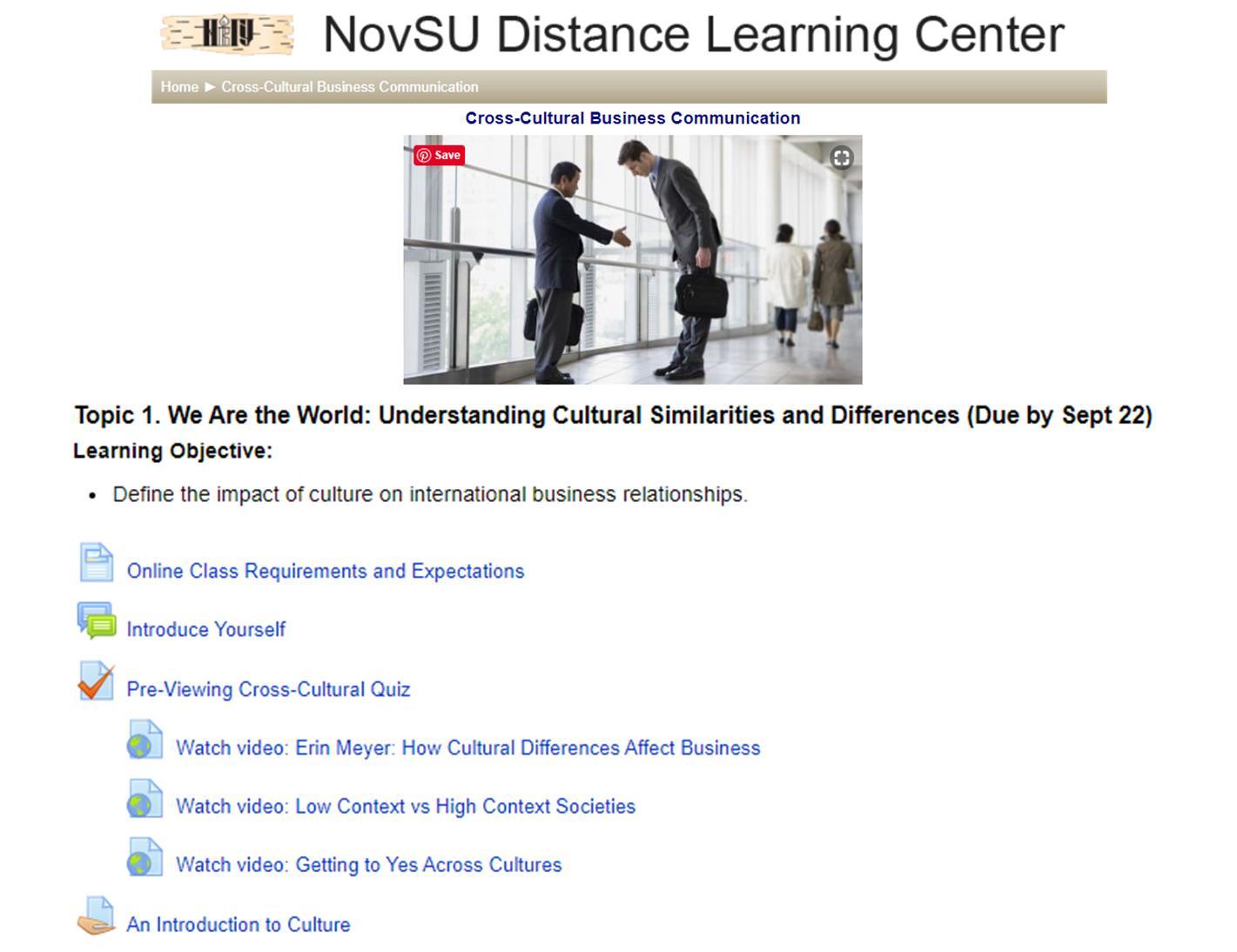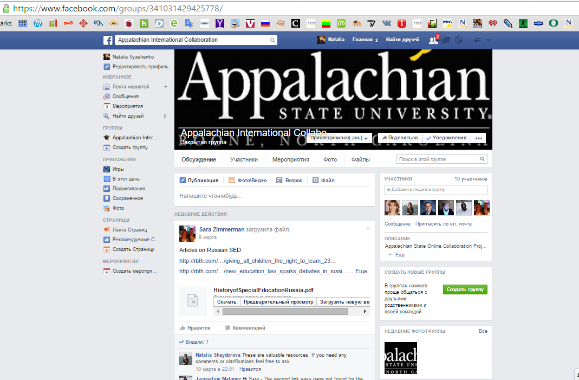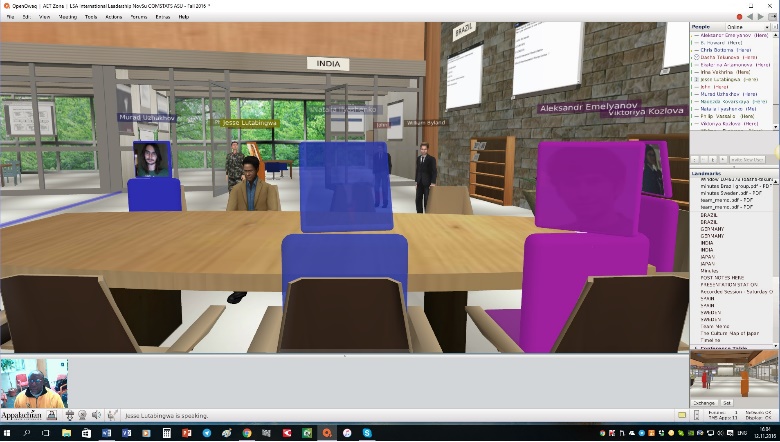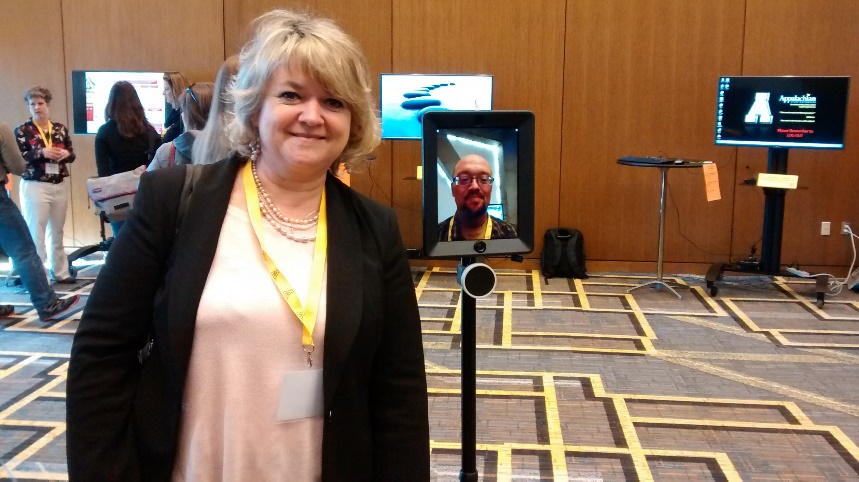Abstract
The article presents the experience of Novgorod State University (Veliky Novgorod, Russia) and Appalachian State University (Boone, NC, USA) in the use of digital technologies for virtual academic mobility. It describes the options for use of four technologies in online and blended course teaching – Moodle, Facebook, OpenQwaq and Double Robotics. Studying in the Moodle system, students have the opportunity to familiarize themselves with educational materials on the course website at any time. However, the disadvantage of Moodle is the inability to receive quickly feedback. Unlike Moodle, Facebook allows instantly to transfer information to all members of the group. OpenQwak 3D Virtual World offers a virtual reality where everyone perceives space, movement and the presence of others. Using Double Robotics, a telepresencerobot, allows project participants to make video calls to the screen on wheels, which they control remotely. In addition to the development of virtual academic mobility, the above discussed digital learning technologies allow the inclusion of those who may not have had previous access to education (for example, students with disabilities). This experience could be interesting and useful for a wide audience – instructors, professors, instructional designers, administrators, and assistants – interested in learning the best international practices in the field of online and blended education.
Keywords: Digital technologies in educationFacebookflipped classMoodleOpenQwakTelepresence Robot
Introduction
Novgorod State University (NovSU) and Appalachian State University (AppState) established a formal institutional partnership in June 2011. Over the years, the universities have successfully implemented two exchange programs: Student and Faculty Exchange Program and Hosting of Short-Term Faculty-Led Study Abroad Program, which allowed students to become totally immersed in another culture for a certain period. No doubt, this is an effective way for individuals to absorb the many nuances of a different culture, traditions, language, cuisine, and way of life. However, the above-mentioned approaches have some obvious disadvantages. The current economic situation makes it difficult for many students to be engaged if they do not have the means and support to travel long distances. Creating opportunities for students to engage in cross-cultural interactions that will enhance globalization is an important goal for both universities. Cross-cultural interactions are one of the effective tools for the formation of so-called soft skills, which are of great importance in the context of globalization of society (Gruzdev, Kuznetsova, Tarkhanova, & Kazakova, 2018). In the formation of higher education models, much attention is paid to these aspects (Dudin, Bezbakh, Frolova, & Galkina, 2018).
Digital technologies are increasingly used in the field of education, as evidenced by the numerous studies conducted in this field (Ilyashenko, 2016; Latchem & Khanolainen, 2017; Loshkareva, Luksha, Ninenko, Smagin, & Sudakov, 2017).
Therefore, both Universities agreed to offer an innovative opportunity for instructor and student cooperation online through virtual academic mobility. It was decided to design and co-teach a joint graduate certificate program, making use of digital learning technologies. Providing an online experience with an international partner university may be one means of counteracting these risks and barriers while expanding the number of students who may be included.
Problem Statement
Globalization and appreciation of multiple cultures is a desirable outcome among most universities. To prepare their graduates to engage in an ever increasingly connected world, universities must offer programs that allow students the opportunity to develop necessary knowledge and skills (Tashner, Howard, Ilyashenko, Bashir, & Zimmerman, 2016; Vetkina, Kudryashova, Fikhtner, Trifonov, & Zhukova, 2018). This will enhance the ability of businesses to engage more effectively in international commerce. It will increase overall comfort by citizens in engaging in debates and finding solutions for global issues. However, traveling and studying abroad is not always practical for a large majority of university students. If these experiences can be brought into the classroom, students will benefit from a deeper understanding through sustained interaction with international peers and instructors.
Research Questions
What are the most effective digital technologies for use in joint online teaching?
What are the long-term learning impacts on students who engage in this level of online collaboration with international peers as measured though the quality of collaborative projects, student reflections, and student evaluations of the courses?
What models of distance education pedagogies will best address engaging international students and faculty through online and virtual world environments?
Purpose of the Study
To analyze various digital technologies available for online and blended teaching to determine the effectiveness and impact of such sustained online collaboration among instructors and students in international partnerships.
Research Methods
The course materials offered to students will be assessed to determine if these materials support the established learning goals and student learning objectives for the course. A complete cross-walk of materials will be conducted. The content of student reflections following conclusion of the course will be analyzed using qualitative coding (Saldana, 20--). The results of student evaluations will be examined to determine if the goals of the course are met and to determine student attitudes following participation.
Findings
In this study, we will focus on fairly well-known and well-developed technologies for online learning – Moodle, Facebook, OpenQwaq and Double Robotics.
Moodle
Distance learning system Moodle was chosen intentionally as both universities use this course management system. Besides, it is simple; easy and efficient to use; compatible with a variety of products; and does not place high demands on the browser. Moodle, which is also open source, is 100% suitable for organizing online lessons since it has an optimal set of resource opportunities for independent work of students (Figure
The Moodle Learning Management System (LMS) gives students the opportunity to familiarize themselves with new material before the beginning of classes and repeat it after the class ends; therefore, raising the quality of their training. In a face-to-face class, students often feel uncertain and shy, or they do not have a good knowledge of the language of instruction. Online discussions allow students to take their time to formulate their questions and responds, thus students can express themselves in a greater degree than in a face-to-face class. Studying in the Moodle system, students have the opportunity to familiarize themselves with educational materials on the course website at any time, so to say, “on the go”– using laptops, tablets or smartphones. This system is perfect for training geographically dispersed students, who get an opportunity to communicate with the instructor and with each other at a time convenient for them.

Sharing their experience of using Moodle for online teaching, the project group members agreed on perhaps its only one drawback – the lack of opportunity to receive instant feedback. Online learning is not possible without effective feedback. To ensure this type of communication, Moodle offers using such interactive elements as “Chat”, “Forum” and “Messages”, but none of those resources provide instant feedback. However, Moodle does allow the instructor to be immediately notified via email of any student input, such as posts to forums, answers to quizzes, uploading assignments, etc. Instructors can then quickly view and respond to student work. If, however, the students do not visit the course site or check their e-mail daily, feedback may be delayed.
To increase the possibility of implementation of instant communication and exchange of urgent alerts, the designers of the course decided to use Facebook in the educational process.
Given the digital, social, mobile and “always in touch” lifestyles and learning styles of 21st-century students, social and mobile technologies such as Facebook provide unprecedented opportunities for instant messaging and information exchange and learning in specially created Facebook study groups or personal learning networks (Figure

Facebook groups are an online space where students can communicate and share information with each other and the instructor in a timely manner. It is a great way to work on a collaborative project. However, in an educational environment, it is recommended to create “closed” groups rather than “open” ones. This means that public information is only a list of group members, and the content of the group page is closed, accessible only to members of the group. In this case, in order to interact with classmates in a closed group, they do not need to be added to Facebook friends. In the opinion of American colleagues, this allows restricting the access of group members to each other's personal pages and thus avoiding cyber-bullying.
When a member publishes information on a group page, such as an article link, the other members of the group receive an instant notification with a link to this update on a mobile app on their smartphone or tablet. For example, if the instructor needs to ask an urgent question, or inform about changes to a schedule, or discuss a new publication, he can do so via Facebook. All members of the group are immediately notified of this by their mobile device and respond to it as soon as possible. Using Facebook in the learning process, the instructor can reach his students even while they are on the bus or at home. This opens up new opportunities for teaching and learning. The ability to organize collaboration on Facebook makes it a convenient platform for synchronous discussion and to carry out creative tasks and group projects under the supervision of the teacher. In addition, if there is an interesting discussion in the classroom that risks taking up too much time, students can be encouraged to continue the discussion on Facebook and move on.
OpenQwaq 3D Virtual World
The most significant advantage of the OpenQwak 3D Virtual World is that it offers a great alternative to face-to-face classroom learning for online students. The platform offers a virtual reality where everyone perceives space, movement and the presence of others. Thus, geographically separated students have an exciting opportunity to see each other, communicate, move around in the virtual classroom, view presentations, videos, illustrations, books, as well as jointly edit documents, discuss projects, etc. in real-time. Working in the virtual world is an interesting and exciting experience that increases students' motivation to learn (Brewer, Mitchel, Sanders, Wallace, & Wood, 2015). Project group members stressed that OpenQwaq was well suited for open, creative, innovative learning. The instructor no longer stands in front of the audience, but walks between students, providing guidance or advice in the study of the material, encouraging students to share ideas with each other and work together on assignments and projects (Figure

According to Appalachian's students, they might not be able to get their hands on authentic Russian borscht and blinis, but they do get to experience something that will sustain them into the foreseeable future: immersive learning experience, delivered at the fraction of the cost of a traditional study abroad program. For the student who had never before ventured beyond their county or oblast, this opportunity was a portal to countless new, eye-opening experiences. More than that, it might well lead to a lucrative new international career, where global experience is fully realized. That's transformative education. Today.
Telepresence Robot: Double Robotics
Sharing a classroom with a robot may sound like something from one of the Hollywood movies, but instead of the big screen, it may be coming to students. Project group members tried to use Double Robotics, a telepresence robot, for their virtual academic mobility, which allowed them to make video calls to a screen on wheels that they controlled remotely. The class does not just feature the occasional videotaped guest lectures by co-teaching instructor. Via Double Robotics, the remote instructor can physically came to the classroom, moved around it via the screen from the other side of the world, and communicate with the students and the other instructor. Thus, both instructors were equal partners in the class (Figure

However, this learning technology has a certain disadvantage that would need to be overcome. While the telepresence robot provides a unique advantage in that the co-teaching instructor does not need to be physically located in the same classroom as the students, it raises a concern – the social interaction between the international instructor and the students may potentially be hampered, if students are uncomfortable communicating through the robot or the robot cannot pick up physical cues such as body language and facial expressions of the students. It has been shown that the social interaction between students and their instructor positively influences the students' learning outcomes by improving the students' motivation and helping students see the relevance of topics introduced by the instructor (Zhang & Duan, 2018).
In addition to these technologies, such as Zoom and Google and others are used. Students of the Appalachian State University and Novgorod State successfully use them in their joint work, especially when implementing projects.
Besides the development of virtual academic mobility, the above discussed digital learning technologies allow the inclusion of those who may not have had previous access to education. Underserved and non-traditional students may be defined as those who have challenges that prevent them from attending higher education programs due to disabilities, finances, family obligations, or distance from the university. This is an issue for the Novgorod and other regions of Russia as well as for Appalachian State University. Reaching out to under-served students has figured prominently in the strategic goals and plans of both Novgorod State University and Appalachian State. This research project would allow moving online education from the traditional model of solitary asynchronous work to actual engagement with faculty and peers. Besides, the ability to work virtually using technologies would allow underserved people and people with disabilities have equal employment opportunities.
Conclusion
A whole array of digital learning technologies enabled project group members to actively collaborate with one another. Educators in this age must be on the vanguard. Digital learning technologies are evolving at such a rapid rate that no single faculty member can possibly keep abreast of all innovations. Besides, the ability to work virtually, using such technologies would allow underserved people and people with disabilities to have equal employment opportunities. In this way, the use of digital technologies described above will allow developing a completely new area for international cooperation – virtual academic mobility. Moreover, it is expected that students, who successfully complete this course, will receive certificates of all universities participating in the project. In the future, the course will provide the basis for developing a program of further vocational training called “International Leadership”, designed for leaders in education, business, etc.
References
- Brewer, P. E., Mitchel, A., Sanders, R., Wallace, P., & Wood, D. D. (2015). Teaching and Learning in Cross-Disciplinary Virtual Teams. IEEE Transactions on Professional Communication, 58(2), 208-229. https://doi.org/10.1109/TPC.2015.2429973
- Dudin, M. N., Bezbakh, V. V., Frolova, Е. E., & Galkina, M. V. (2018). The Models of Higher Education in Russia and European Countries at the beginning of the XXIst century: the Main Directions of Development. European Journal of Contemporary Education, 7(4), 653-667. https://doi.org/10.13187/ejced.2018.4.653
- Gruzdev, M. V., Kuznetsova, I. V., Tarkhanova, I. Yu., & Kazakova, E. I. (2018). University Graduates' Soft Skills: the Employers’ Opinion. European Journal of Contemporary Education, 7(4), 690-698. https://doi.org/10.13187/ejced.2018.4.690
- Ilyashenko, N. (2016). Strategies for the formation of an inclusive environment: a collection of scientific papers based on the materials of the international scientific-practical conference “University as a heterogeneous organization: strategies for the formation of an inclusive environment” / comp. M.N. Pevzner, P.A. Petryakov, ed. N.V. Bogatenkova. SPb: SPb APPO. [in Russ.].
- Latchem, С., & Khanolainen, D. (2017). Open and distance lifelong non-formal learning for self-development: current practices and possible applications in Russian contexts. Education and Self Development, 12(2), 12-30. https://doi.org/10.26907/esd12.2.02
- Loshkareva, E., Luksha, P., Ninenko, I., Smagin, I., & Sudakov, D. (2017). Skills of the future What you need to know and be able to in a new complex world. Future Foundation Expert Council Report from https://worldskills.ru/assets/docs/media/WSdoklad_12_okt_rus.pdf [in Russ.].
- Tashner, J., Howard, B., Ilyashenko, N., Bashir, A., & Zimmerman, S. (2016). International Collaboration in Developing and Teaching an Online Course in Global Perspectives of Educational Leadership. – February 2016 at the Conference of Higher Education Pedagogy, Virginia Tech, Blacksburg, VA. USA. Retrieved August 12, 2019, from: https://chep.teaching.vt.edu/content/dam/chep_teaching_vt_edu/CHEP_2016_Proceedings-1.pdf
- Vetkina, A., Kudryashova, T., Fikhtner, O., Trifonov, V., & Zhukova, E. (2018). The Innovative Potential of Digital Transformation of the Russian Higher Education System: Trends of the Competence Approach. Proceedings of the International Conference on the Theory and Practice of Personality Formation in Modern Society (ICTPPFMS 2018). Atlantis Press. Advances in Social Science, Education and Humanities Research, 198, 197-203. https://doi.org/10.2991/ictppfms-18.2018.35
- Zhang, M., & Duan, P. (2018). Development of Telepresence Teaching Robots with Social Capabilities. Proceedings of the ASME 2018 International Mechanical Engineering Congress and Exposition IMECE2018, November 9-15, 2018, Pittsburgh, PA, US. Retrieved August 16, 2019, from: https://www.researchgate.net/publication/328979587_Development_of_Telepresence_Teaching_Robots_With_Social_Capabilities
Copyright information

This work is licensed under a Creative Commons Attribution-NonCommercial-NoDerivatives 4.0 International License.
About this article
Publication Date
26 August 2020
Article Doi
eBook ISBN
978-1-80296-086-0
Publisher
European Publisher
Volume
87
Print ISBN (optional)
-
Edition Number
1st Edition
Pages
1-812
Subjects
Educational strategies, educational policy, teacher training, moral purpose of education, social purpose of education
Cite this article as:
Kudryashova, T. V., Ilyashenko, N. N., Howard, B. B., & Wallace, P. (2020). Digital Technology In Service Of Virtual Academic Mobility. In S. Alexander Glebovich (Ed.), Pedagogical Education - History, Present Time, Perspectives, vol 87. European Proceedings of Social and Behavioural Sciences (pp. 163-170). European Publisher. https://doi.org/10.15405/epsbs.2020.08.02.21

